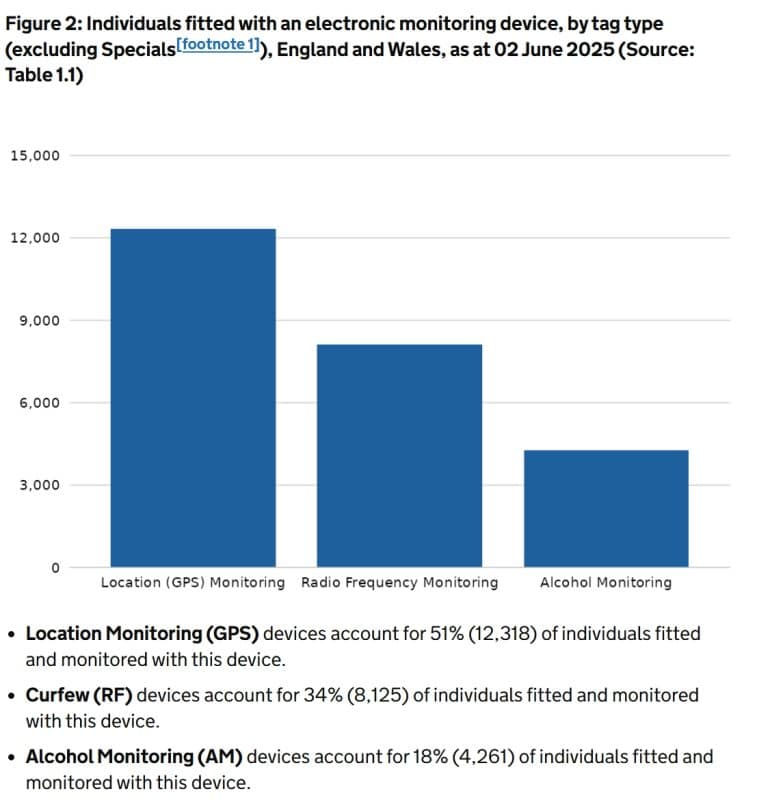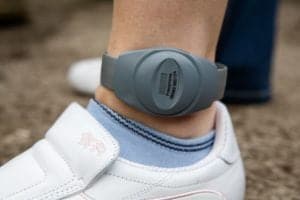Tagging
Given the Government’s repeated commitments to substantially expand the use of electronic monitoring, it seemed worthwhile to provide a short overview of the latest management information on tagging published by the MoJ yesterday (28 August 2025). The publication provides information about everyone subject to electronic monitoring on 2 June this year which amounted to 23,977 individuals.
Background
Electronic monitoring is a way of remotely monitoring and recording information on an individual’s whereabouts or alcohol consumption, using an electronic device that is typically fitted to an individual’s ankle. Electronic monitoring may be used:
- as a condition of court bail;
- as a requirement of a court sentence, primarily community orders and suspended sentence orders;
- for Home Detention Curfew;
- as a licence condition following release from custody;
- as a condition of immigration bail, managed by the Home Office; or
- to intensively monitor a small number of individuals, including: some of the highest-risk offenders managed under Multi-Agency Public Protection Arrangements (MAPPA); those granted bail by the Special Immigration Appeals Commission (SIAC); and those made subject to Terrorism Prevention and Investigation Measures (TPIMs).
Types of monitoring
There are three main types of devices:
Location Monitoring (GPS) devices account for 51% (12,318) of individuals fitted and monitored with this device.
Curfew (RF) devices account for 34% (8,125) of individuals fitted and monitored with this device.
Alcohol Monitoring (AM) devices account for 18% (4,261) of individuals fitted and monitored with this device.
Location Monitoring (GPS)
GPS devices allow the monitoring of:
- compliance with exclusion zones;
- attendance at a required activity or appointment;
- an offender’s whereabouts, known as trail monitoring;
- multiple conditions or requirements, if necessary, such as a combination of exclusion zones, curfew, monitored attendance and trail monitoring.
The total number of individuals fitted with an electronic monitoring device, and whose primary order was a location monitoring order as at 02 June 2025 was 12,318. This cohort comprised:
- 4,202 Court bail, 34% of the GPS monitored individuals.
- 4,008 Immigration, 33% of the GPS monitored individuals.
- 3,391 Post release, 28% of the GPS monitored individuals.
- 717 Court sentence, 6% of the GPS monitored individuals.
Curfew Monitoring (RF)
RF devices allow the monitoring of a curfew, where an offender must be at a specified location at specified times
The total number of individuals fitted with an electronic monitoring device and whose primary order was a curfew order as at 02 June 2025 was 8,125.
Court bail RF orders make up the largest proportion (49%) of RF monitored individuals. At 02 June 2025, 3,950 individuals had RF court bail as their primary order type.
Post-release RF orders were the second-largest group, with 3,001 individuals (37% of the RF caseload).
Court sentence RF orders (community orders and suspended sentence orders) were the third-largest group with 1,174 individuals (14% of the caseload).
Alcohol Monitoring
There are two types of alcohol monitoring:
Alcohol Abstinence and Monitoring Requirement (AAMR) – this may only be used when sentencing for alcohol-related criminal behaviour and it imposes a total ban on drinking alcohol for up to 120 days. Compliance with the ban is monitored electronically using an alcohol monitoring device, which monitors for the consumption of alcohol via an offender’s sweat. An AAMR can only be imposed if the individual is not alcohol dependent or has an Alcohol Treatment Requirement (ATR), and the individual is an adult (18 years or over).
Alcohol Monitoring on Licence (AML) – this is an additional licence condition for offenders released from custody whose offending and risk is alcohol related. There are two licence conditions available, total abstinence from alcohol, or a requirement that the offender complies with requirements specified by their probation practitioner to address their alcohol needs, which will include restricting alcohol use.
The total number of individuals fitted with an alcohol monitoring device as at 02 June 2025 was 4,261. This is a substantial increase on three years ago when there were less than one thousand people subject to this form of EM.
Electronic monitoring using a non-fitted device was introduced in November 2022 for the immigration cohort. These devices utilise periodic biometric verification as an alternative to fitted devices. Individuals with a non-fitted device are included within this GPS cohort in this MoJ statistical bulletin.
Unfortunately, I can’t give clear figures on the trends in use of other forms of EM. This is because Serco took over the delivery of the service from Capita in May 2024 and from that date to 2 June 2025 some people were counted as being on a tag in both Serco and Capita systems making it impossible to reliable calculate the numbers on different types of tag at different dates.
Nevertheless, it is clear that the overall trend is upwards and that this trend is likely to accelerate over the course of this Government.
Thanks to Andy Aitchison for kind permission to use the header image in this post. You can see Andy’s work here






